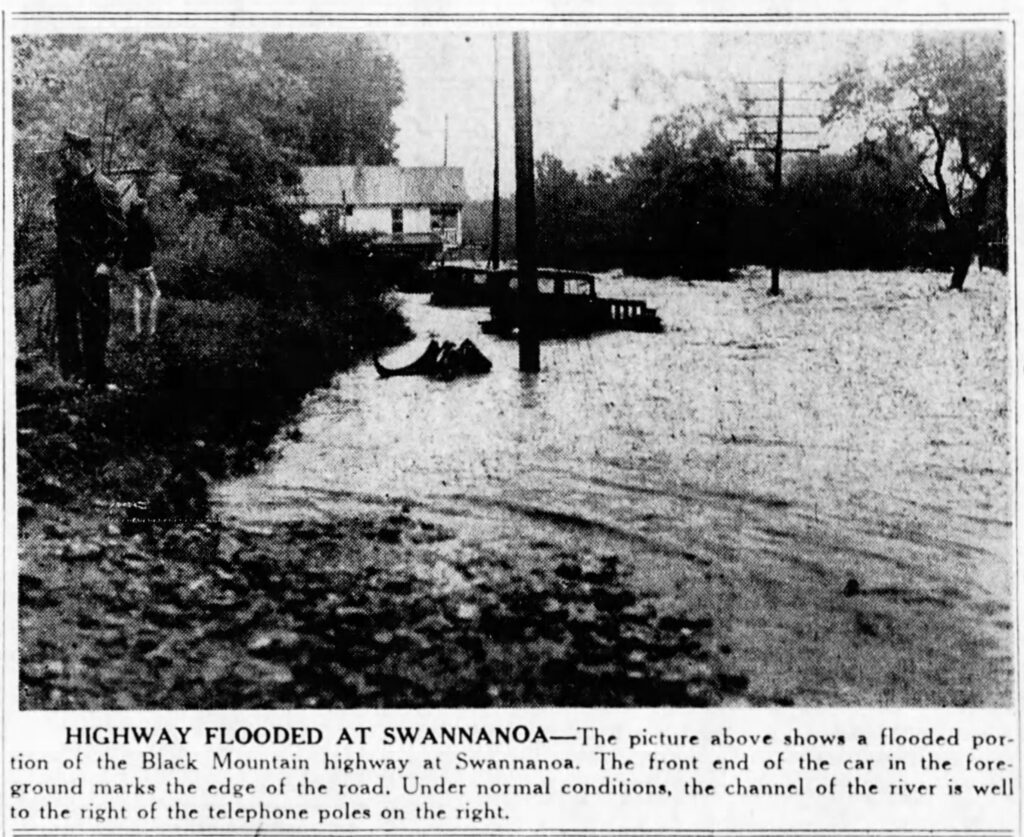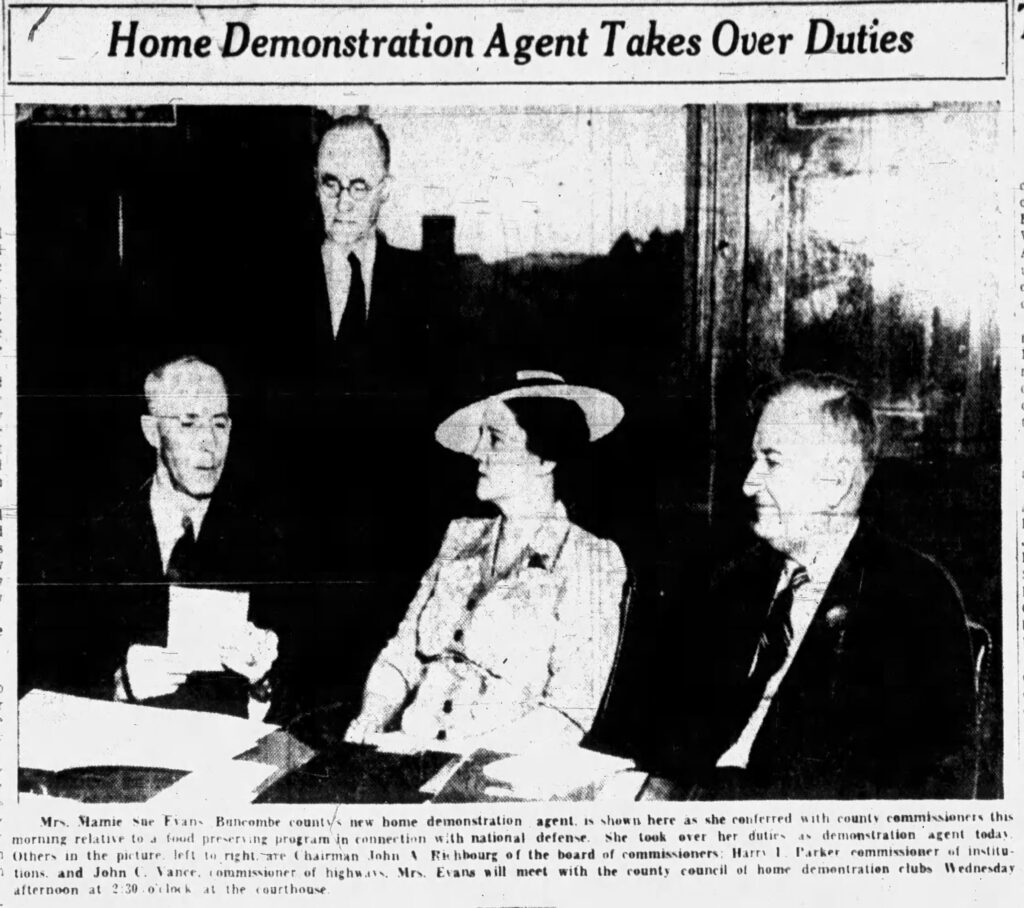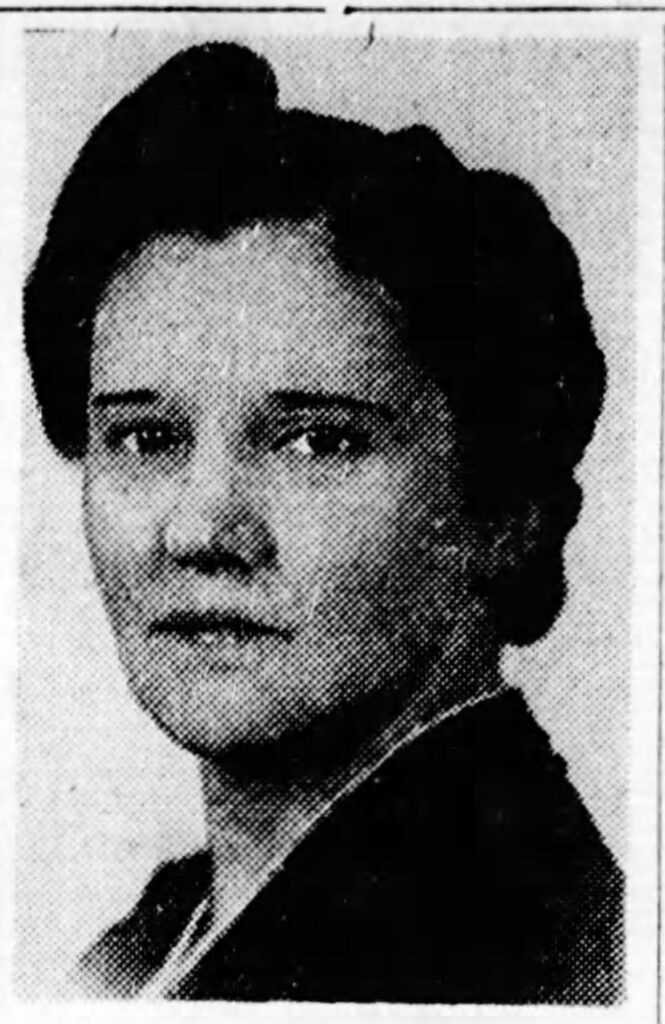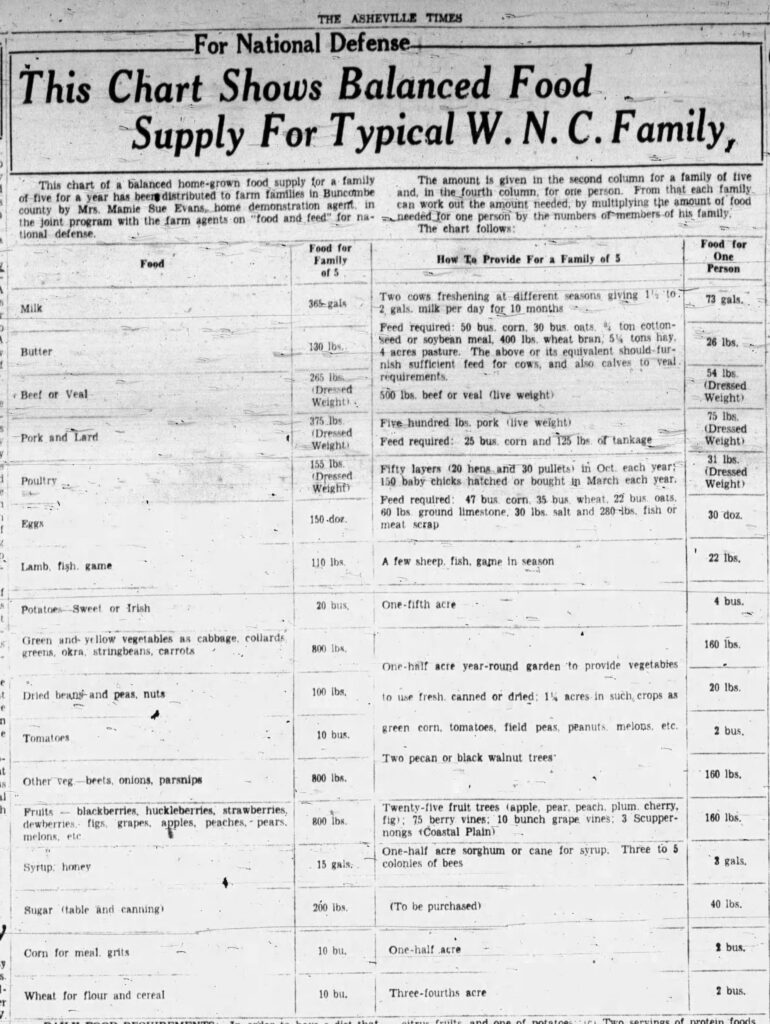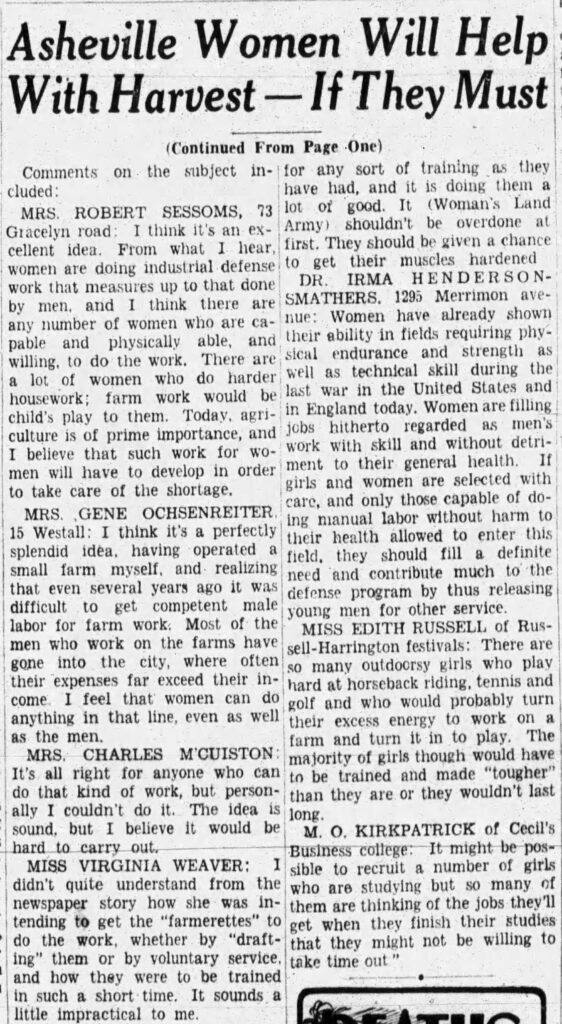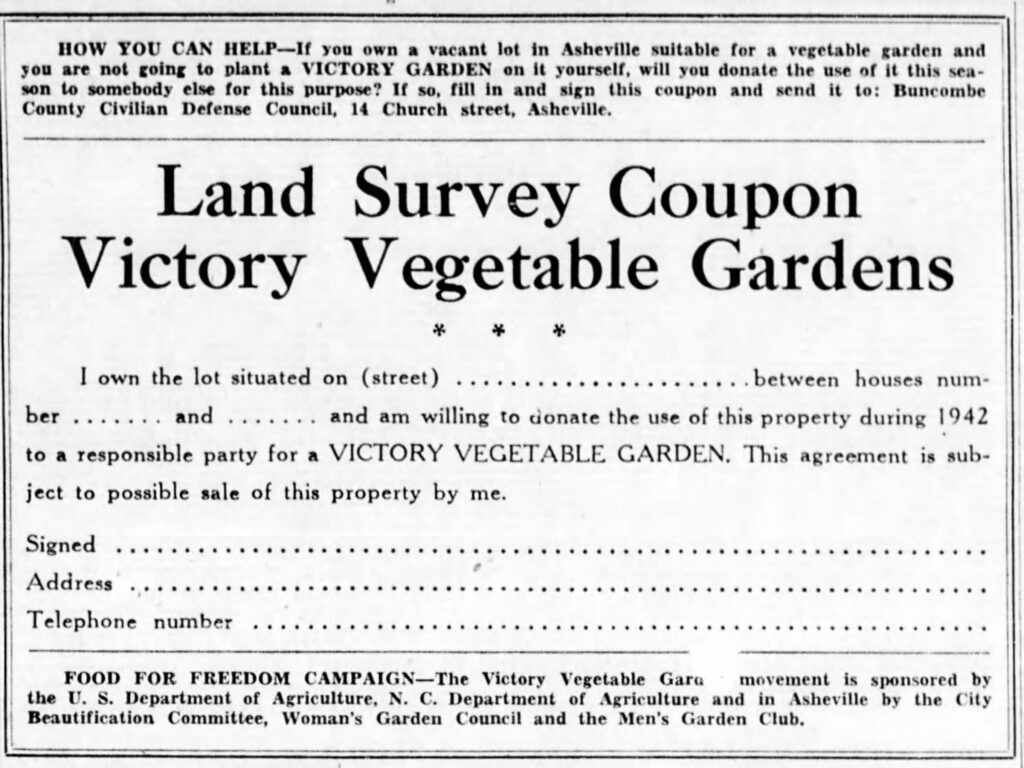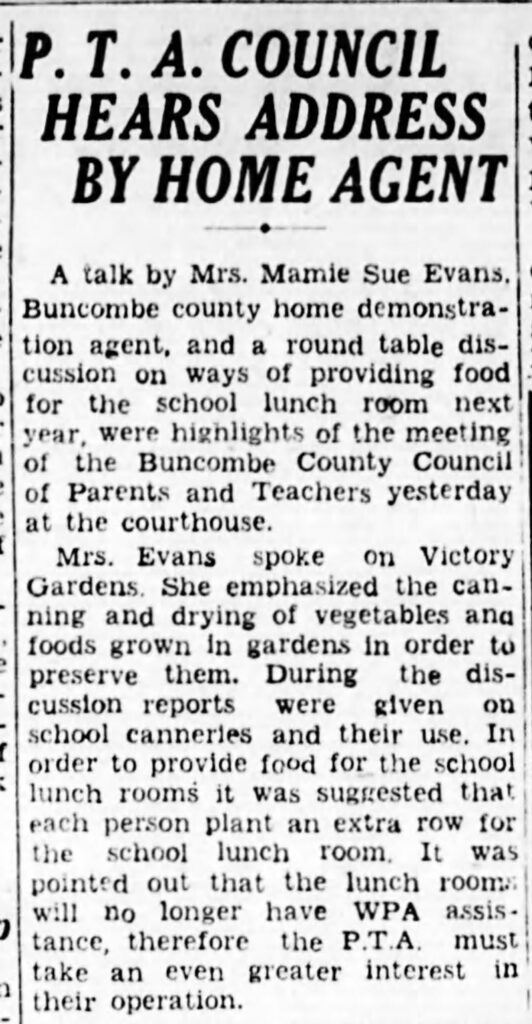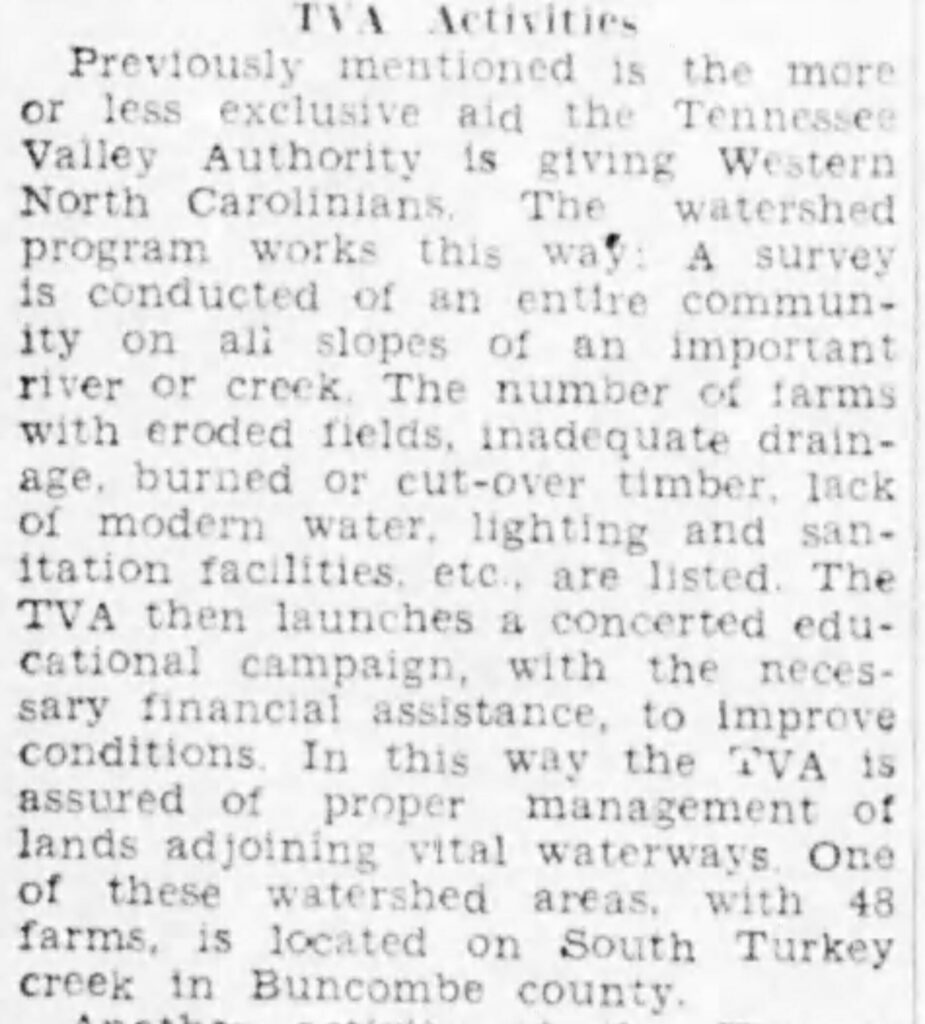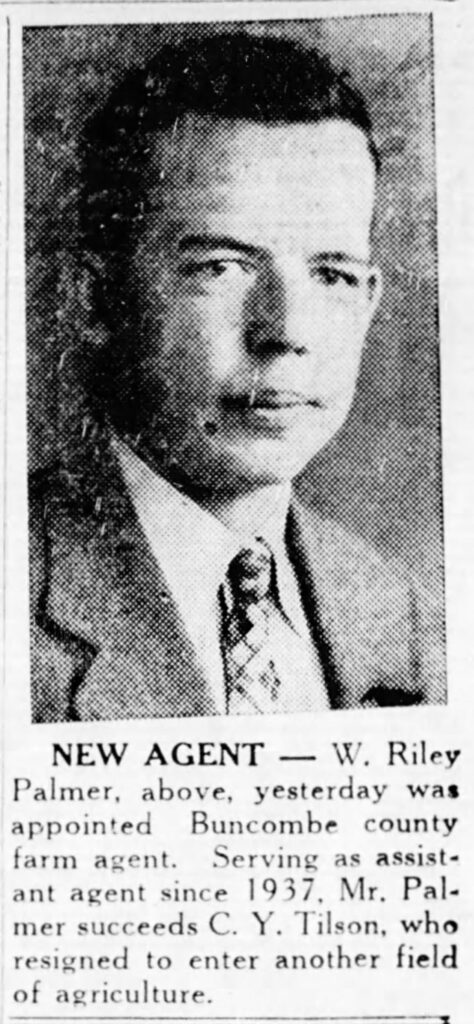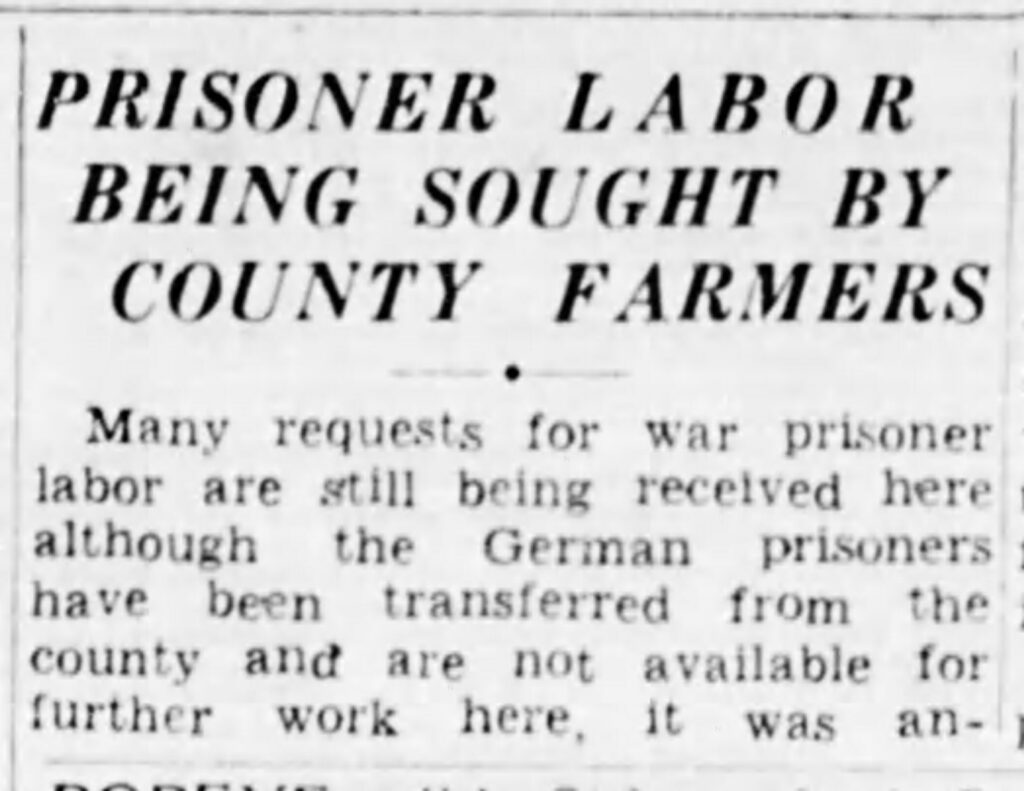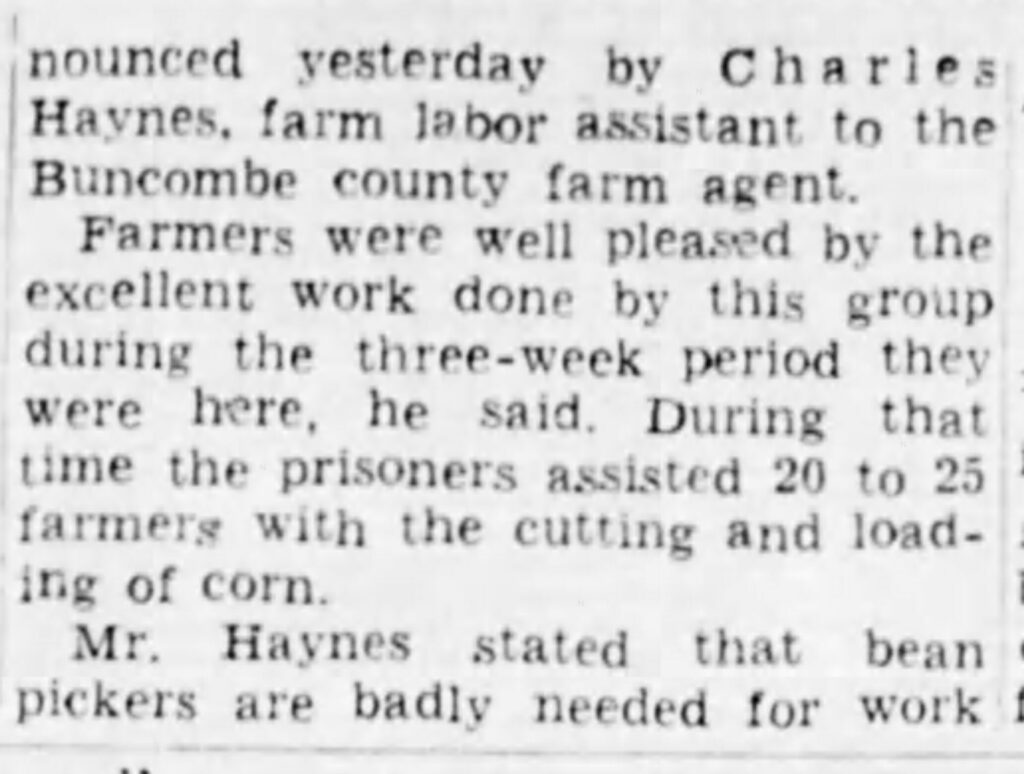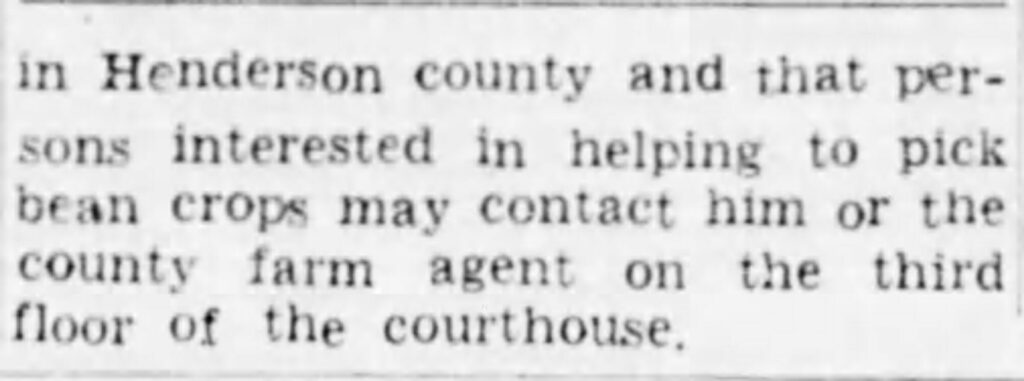Buncombe County Cooperative Extension: The 1940s
go.ncsu.edu/readext?1059977
en Español / em Português
El inglés es el idioma de control de esta página. En la medida en que haya algún conflicto entre la traducción al inglés y la traducción, el inglés prevalece.
Al hacer clic en el enlace de traducción se activa un servicio de traducción gratuito para convertir la página al español. Al igual que con cualquier traducción por Internet, la conversión no es sensible al contexto y puede que no traduzca el texto en su significado original. NC State Extension no garantiza la exactitud del texto traducido. Por favor, tenga en cuenta que algunas aplicaciones y/o servicios pueden no funcionar como se espera cuando se traducen.
Português
Inglês é o idioma de controle desta página. Na medida que haja algum conflito entre o texto original em Inglês e a tradução, o Inglês prevalece.
Ao clicar no link de tradução, um serviço gratuito de tradução será ativado para converter a página para o Português. Como em qualquer tradução pela internet, a conversão não é sensivel ao contexto e pode não ocorrer a tradução para o significado orginal. O serviço de Extensão da Carolina do Norte (NC State Extension) não garante a exatidão do texto traduzido. Por favor, observe que algumas funções ou serviços podem não funcionar como esperado após a tradução.
English
English is the controlling language of this page. To the extent there is any conflict between the English text and the translation, English controls.
Clicking on the translation link activates a free translation service to convert the page to Spanish. As with any Internet translation, the conversion is not context-sensitive and may not translate the text to its original meaning. NC State Extension does not guarantee the accuracy of the translated text. Please note that some applications and/or services may not function as expected when translated.
Collapse ▲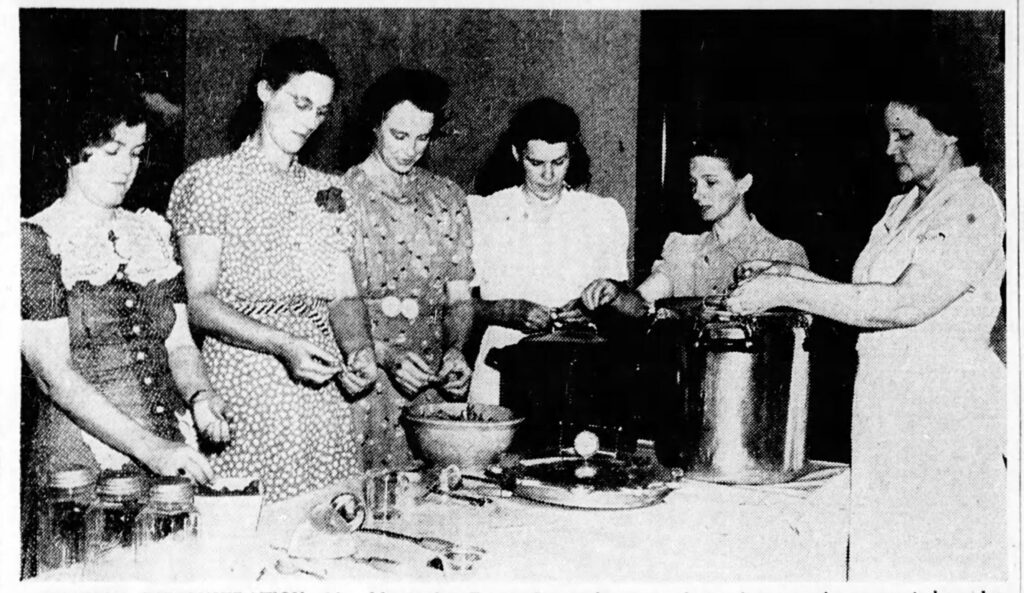
Mamie Sue Evans, Buncombe County Home Demonstration Agent, hosts a canning class for leaders of local home demonstration clubs. Left to Right: Mrs. W.H. Stevens, Mrs. W.J. Thompson, Mrs. George Buckner, Miss Margaret Brumbleoe, Mrs. Clyde Gentry, and Mrs. Evans.
The Asheville Citizen newspaper.
Monday, July 7, 1941.
Page 8.
“I’ve never known a group of people more independent. They lived off the land and asked nothing of anyone. I have never known a finer group. I would put the women of the mountains–the families of the mountains–above all others in North Carolina.
–Mamie Sue Evans, Buncombe County Home Demonstration Agent (1941-1957)
The Asheville Times newspaper. May 12, 1982
The 1940s proved to be a transformative time in American history. As the decade began, the people of our nation were contemplating their place in world conflicts. Hitler’s military had invaded Poland in September, 1939, marking the beginning of World War II but it was not until December 7, 1941 that the surprise attack on Pearl Harbor, Hawaii, woke the sleeping giant and hurled the United States into war.
World War II had a profound effect on all aspects of American life. An increased industrial demand for products and the movement of women filling jobs previously held by men led to economic acceleration and continued women’s rights movements. The war also served as a catalyst in the burgeoning Civil Rights movement, as American soldiers of color returned home equally deserving the benefits given to others but still facing discrimination under the law.
The decade was a time of immense pressure on American farmers to increase production. “Victory Gardens” became popular as a way to show support for the war and to encourage more people to grow their own food, thus easing domestic demand.
June 6, 1944 — D Day — proved to be a turning point in the war, when the Allied Forces landed on the shores of Normandy, France, defeating the Axis Forces and liberating western Europe from Nazi control.
Though the tide had turned in our country’s favor, the war was not over, and it took near annihilation through the dropping of two atomic bombs for the war to come to an end in 1945. The young men and women who did return home could finally begin the long process of physical and emotional healing.
1940
The 1940 Buncombe County Agricultural Census lists 4,203 farms in the county (including full and part owners) with 182,249 acres farmed. Of that 31,323 acres are dedicated to growing crops.
August 13 – The first of two major floods occurs in Asheville and other sections of Western North Carolina. This first storm brought over 4.5 inches of rain to Asheville and as much as 12 inches to other parts of the region in a matter of three days.
August 30 – The second major flood occurs after Asheville alone is inundated with almost 7 inches of rain on August 29th and August 30th.
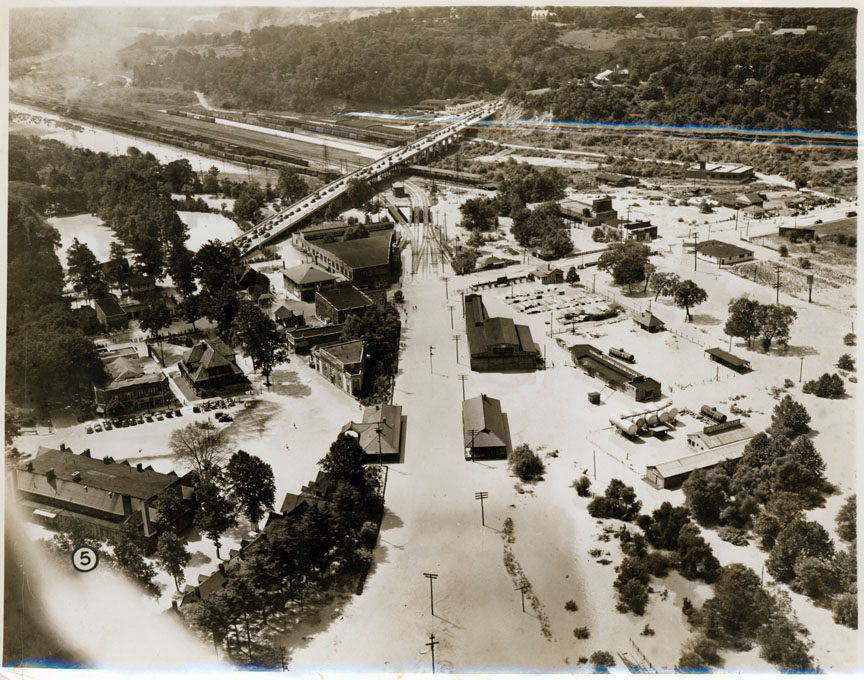
Biltmore Village and McDowell Street Bridge after flooding.
Note the railroad tracks under water in the center of the photo.
The Asheville Citizen newspaper.
August 31, 1940.
Page 8.
1941
January 3 – Buncombe County Farm Agent C.Y. Tilson presents the nationwide “Mattress Manufacturing” program, a Cooperative Extension initiative, to the Buncombe County Board of Commissioners. The program provided low-income families with cotton, ticking, instruction, and supervision for mattress making at a cost of $1.50 per mattress, valued at $10.
June 2 – Mamie Sue Evans becomes Buncombe County’s newest Home Demonstration Agent.
One of her first programs was the “Food for National Defense” food planning program. Aimed at rural families, it prescribed a detailed gardening plan and canning, targeting 575 quarts of preserved vegetables for a family of five, including 100 quarts of tomatoes and 35 quarts of tomato soup mix. Achieving this required growing at least 10 bushels of tomatoes. The program also emphasized drying and storing other produce and cultivating a fall garden.
Born December 14, 1895 in Rankin County, Mississippi, Mamie Sue Evans served as the Home Demonstration Agent for Buncombe County from 1941 until her retirement in 1957. A graduate of the Mississippi State University for Women, she accepted the position of Home Demonstration Agent for Johnston County, North Carolina, in 1918. Later working for Jackson County Cooperative Extension, she met Harry Evans, a drugstore owner. They married in 1924 and had three children. In her 31 years as a Home Demonstration Agent, she taught many rural families skills to make their lives better, everything from home-canning to cheese making, gardening skills and mattress making, to distributing clothing patterns and helping in their construction, all while taking care of a husband and family of her own, and never making more than $6,000 a year. Mamie Sue Evans died in Asheville, January 22, 1990 at age 94.
September 11 – The Asheville Times newspaper publishes this chart, furnished by Buncombe County Cooperative Extension, showing the balanced food supply for a typical WNC family.
September 15 – Buncombe County ranks first in North Carolina in dairy farming, raising more dairy cattle than any other county, and second in burley tobacco with an average yearly production of 1,560,000 pounds on roughly 1300 acres. Buncombe County also led all other North Carolina counties in the use of lime while ranking second in the state in the use of phosphate, improving the land and nutrients in the soil.
November 25 – First Lady Eleanor Roosevelt promotes the idea of a “Women’s Land Army” to work at harvesting the next year’s fall crops. Women of Asheville gave their opinions to the Asheville Times newspaper with some enthusiastic about the job.
December 7 – Japanese military forces launch a surprise attack on the US Naval Fleet stationed in Pearl Harbor, Hawaii. Over 3,500 men and women are killed or wounded.
December 8 – President Franklin D. Roosevelt delivers his “Day of Infamy” speech to Congress who then declares war against Japan, ushering the United States into World War II.
1942
February – Buncombe County Farm Agent C.Y. Tilson leads a “Victory Garden” project with the Asheville Beautification Association. Participation of every family was encouraged in order to provide an adequate supply of produce for families’ needs due to the shortage of metal containers, increase in war demands, and the increasing price of food. Gardens could be grown in rural areas as well as in the city and those with land were encouraged to donate it for this specific purpose.
October – During Buncombe County’s October 1st – 31st scrap metal drive, Cooperative Extension’s C.Y. Tilson and Mamie Sue Evans urged farmers and rural community leaders to participate. The drive yielded 12,042,015 pounds of scrap for Buncombe County, including iron from the former county jail and downtown Asheville’s streetcar rails. Arthur Taylor led individual collections with 39,785 pounds. Schools were major contributors to the cause with south Asheville’s Valley Springs School (present day site of Koontz Intermediate School) collecting 434,556 pounds, averaging 687.5 pounds per pupil. In the city, St. Genevieve of the Pines School (present day site of AB Tech’s Ferguson Center) collected 65,265 pounds, averaging 235.6 pounds per pupil. Funds raised were donated to war time charities and participants were offered war bonds and other prizes.
1943
January 12 – Approximately 150 Buncombe County farmers and agricultural leaders convene at the courthouse for National Farm Mobilization Day. This meeting aimed to boost local agricultural production in order to fulfill the wartime demand for food at home and abroad. Specific goals for Buncombe County included a 22% increase in egg production, 2,500 additional acres of corn, 2,700 acres of wheat, 1,200 additional acres of hay and 820 additional acres of potatoes, among others.
February 13 – Home Demonstration Agent Mamie Sue Evans meets with representatives from several Buncombe County schools on ways of providing food for school lunches. Victory Gardens and drying and preservation of foods were discussed as well as growing an extra row in the home garden to give to the school lunch room.
September – A new Watershed Plan is launched in Sandy Mush. Watershed Programs began with the creation of the TVA in 1933. The first watershed programs in Buncombe County included Turkey Creek (in Leicester) and Fairview. Buncombe County Cooperative Extension, working in tandem with the TVA, encouraged farmers to improve their land by following soil conservation techniques in farming and land management, the use of fertilizer and other soil amendments, tree planting, and other measures to improve the soil, the water quality, and as a means of flood control.
1944
January 10 – Free food, room and board for $1.25, free transport to and from Asheville to Florida with free medical care, and the chance to make at least $35.00 a week were some of the benefits offered by Buncombe County Cooperative Extension to the first 140 qualified men who were able to temporarily relocate to Florida to help harvest the orange, tangerine, and grapefruit crops in 1944. Buncombe County Farm Agent C.Y. Tilson explained that this was a reciprocal measure, offering assistance to Florida who had previously sent men to western North Carolina to help with our own shortage of harvest crews.
July 1 – W. Riley Palmer is appointed new Farm Agent for Buncombe County after the resignation of C.Y. Tilson.
A native of Haywood County, Palmer attended Brevard College and NC State University. Beginning his 36 year career with Buncombe County Cooperative Extension in 1937 as the Assistant Farm Agent for the county, he served as Farm Agent from 1944 until his retirement in 1973.
September – During World War II, when farm labor was scarce, both Buncombe and Henderson Counties employed German prisoners of war to assist with harvesting.
Henderson County housed two German prisoner of war camps during World War II. Located at the Bowen Farm on NC 191in the Rugby community and the WNC Fairgrounds (current location of East Henderson High School). These camps became vital sources of labor for harvesting crops as the county faced severe manpower shortages.
1945
May thru August – Germany officially surrenders to the Allied Forces, ending the war in Europe. A declaration of surrender is later offered to Japan. Their refusal to surrender leads to devastating consequences in August, 1945 with the dropping of two atomic bombs. The first on Hiroshima, on August 6 and the second on Nagasaki on August 9.
September 2 – The Japanese government signs and agrees to official surrender documents, bringing a close to World War II.
1946
May 21 – The NC Department of Agriculture provides a Crop Reporting station to the Buncombe County courthouse. This new feature provides market news, prices, crop reports and information from throughout the nation to Asheville’s newspapers and radio stations in real time.
September 8 – The Farmers Federation launches a project of flower bulb growing in Buncombe County. One farmer participating was Harvey Heywood of Reems Creek. After three successful years of growing tulip bulbs, he was convinced that an acre of tulip bulbs would generate a greater net income than growing an acre of burley tobacco and proved to be a great supplemental crop to farmers of WNC. The climate, terrain, and sandy loam soil of the area proved to be successful factors in bulb growing, including gladiolus and dahlias, which are still grown commercially today.
1947
Yearly statistics for 1947 include:
4,060 families on 5,710 farms in the county worked with Buncombe County Cooperative Extension during the calendar year.
Burley Tobacco acreage increased from 1,243 acres in 1946 to 1,324 acres in 1947.
Seventeen 4-H Clubs were active in the county with 245 boys and 598 girls participating.
165 Grade A Dairies within Buncombe County with 15 producer-distributors selling milk products to consumers.
1949
February 28 – After being introduced in 1947, work was completed and The Asheville Agricultural Development Council is created by the Asheville Chamber of Commerce.
This organization aimed to bolster the region’s agricultural economy and foster unity among isolated rural communities. Activities included forming official community clubs and providing essential support such as indoor plumbing, food, and clothing to needy families. Operating until the early 1980s, it transitioned into the Western North Carolina Development Association. Later, in the early 2000s, it merged with the WNC Associated Communities. The two combined became WNC Communities, which continues to support grassroots initiatives and community development programs across Western North Carolina.
The 1940s were a period of intense transformation for the United States, primarily driven by World War II and its aftermath. While men served in the military, women entered the workforce in unprecedented numbers, and wartime industrial production ended the Great Depression. Returning soldiers often struggled with psychological trauma, a condition largely misunderstood at the time while women, who had experienced greater independence during the war, navigated their evolving roles in society. As the decade closed, the desire for family-oriented living fueled the “baby boom” and the growth of suburbs, reshaping both the physical landscape and cultural norms of the nation.The post-war era saw a surge in consumerism, with increased demand for cars, homes, and emerging technologies such as television and transistor radios that offered new forms of communication and entertainment.
Join us in May as we explore the changes, challenges, and accomplishments the 1950s brought to Buncombe County and Cooperative Extension.
Follow our history all year long as we explore each decade of North Carolina Cooperative Extension work in Buncombe County:
Buncombe County Cooperative Extension: Beginnings to 1920
Buncombe County Cooperative Extension: The 1920s
Buncombe County Cooperative Extension: The 1930s
Sources:
“150 Buncombe Farmers Told About Task Ahead.” The Asheville Citizen, 13 Jan. 1943, p. 9, Accessed 24 Mar. 2025.
“3 Watershed Projects to Be Launched.” The Asheville Citizen Times, 2 Feb. 1936, p. 6, Accessed 25 Mar. 2025.
“Agricultural Extension Work.” The Asheville Citizen, 22 Dec. 1947, p. 10, Accessed 25 Mar. 2025.
Brower, Nancy. “Mamie Sue Evans at 87.” The Asheville Times, 12 May 1982, p. 1, Accessed 24 Mar. 2025.
“Buncombe County Forges Ahead with Farm Program.” The Citizen Times, 15 Sept. 1941, p. 12, Accessed 24 Mar. 2025.
“Buncombe Exceeds Scrap Quota With 12,042,015 Pounds.” The Asheville Citizen Times, 1 Nov. 1942, p. 1, Accessed 24 Mar. 2025.
Coulter, Adam. “Avery’s Creek United Methodist Church – Celebrating 150 Years.” Unpublished. 2019.
“Farm Families Told How They Can Aid Defense.” The Asheville Citizen, 7 July 1941, p. 8, Accessed 24 Mar. 2025.
“History of Agricultural Council, Since Its Inception As A Project of the Chamber of Commerce to the Formation of Its Present Council.” The Asheville Citizen Times, 23 Oct. 1949, p. 17, Accessed 25 Mar. 2025.
“Iron Bars and Doors of Old Jail Added to Scrap Pile.” The Asheville Citizen Times, 4 Oct. 1942, p. 2, Accessed 24 Mar. 2025.
“Market News to Be Given WNC Farmers.” The Asheville Times, 21 May 1946, p. 12, Accessed 25 Mar. 2025.
“New Watershed Plan Launched at Sandy Mush.” The Asheville Citizen, 24 Sept. 1943, p. 16, Accessed 24 Mar. 2025.
“Our History.” WNC Communities, wnccommunities.org/our-history/. Accessed 25 Mar. 2025.
“Palmer Is New Farm Agent Here.” The Asheville Citizen, 30 June 1944, pp. 1–2.
“Plan Mattress Manufacturing Project Here.” The Asheville Citizen, 3 Jan. 1941, p. 6, Accessed 24 Mar. 2025.
“Prisoner Labor Being Sought by County Farmers.” The Asheville Citizen, 23 Sept. 1944, p. 8, Accessed 25 Mar. 2025.
“PTA Council Hears Address by Home Agent.” The Asheville Citizen Times, 14 Feb. 1943, p. 14, Accessed 24 Mar. 2025.
“Riley Palmer New Farm Agent for Buncombe.” The Asheville Times, 30 June 1944, p. 8, Accessed 25 Mar. 2025.
“Rural Committees Asked to Help in Scrap Drive.” The Asheville Citizen, 1 Oct. 1942, p. 8, Accessed 24 Mar. 2025.
“Search Census Archive.” United States Department of Agriculture Census of Agriculture Historical Archive, agcensus.library.cornell.edu/census_parts/1940-north-carolina/. Accessed 24 Mar. 2025.
“Tilson Recruits Men to Harvest Florida Crops.” The Asheville Citizen, 11 Jan. 1944, p. 7, Accessed 25 Mar. 2025.
“Victory Garden Plan Discussed by Farm Agent.” The Asheville Citizen, 3 Feb. 1942, p. 3, Accessed 24 Mar. 2025.
“WNC Bulb Growing Tests Successful.” The Asheville Citizen Times, 8 Sept. 1946, p. 1, Accessed 25 Mar. 2025.






